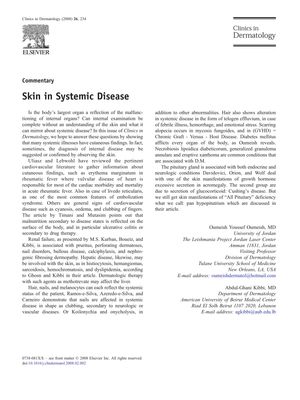Skin in Systemic Disease
May 2008
in “
Clinics in Dermatology
”

TLDR Skin problems can indicate different diseases inside the body.
The document discusses how various systemic diseases can manifest through skin conditions, suggesting that the skin can be an indicator of internal health issues. Cardiovascular diseases may present cutaneous findings such as erythema marginatum in rheumatic fever and livedo reticularis in embolization syndrome. Malnutrition, often secondary to diseases like ulcerative colitis or drug therapy, also has dermatological manifestations. Renal failure is associated with skin issues like pruritus and nephrogenic fibrosing dermopathy, while liver diseases can lead to conditions such as histiocytosis and hemochromatosis. The article also notes that systemic diseases can affect hair and nails, with conditions like telogen effluvium and scarring alopecia being linked to systemic stressors and diseases like chronic graft versus host disease. Diabetes mellitus can cause skin conditions such as necrobiosis lipoidica diabeticorum. Additionally, the document mentions that hormonal imbalances from the pituitary gland, such as in acromegaly and Cushing's disease, can lead to skin manifestations. Overall, the document emphasizes the importance of considering skin symptoms in the diagnosis of systemic diseases.





